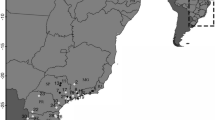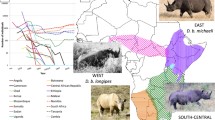Abstract
The American bullfrog, Rana (Lithobates) catesbeianus, is endemic to eastern North America, but has been introduced to approximately 40 countries on four continents and is considered one of the hundred worst invasive alien species in the world. Here, we investigated the genetics of invasive bullfrogs in the Willamette Valley, Oregon, USA, where bullfrogs are widespread and abundant to determine: (1) the minimum number of bullfrog introductions; (2) the native source population(s); and (3) whether genetic variation is reduced compared to source populations. To answer these questions, we analyzed partial sequences of the mitochondrial cytochrome b gene for 251 bullfrogs from the Willamette Valley and the native range. We found that bullfrogs from the Mississippi River basin and Great Lakes region were introduced at least once to the Willamette Valley. Genetic variation measured as haplotype diversity (h) and nucleotide diversity (π n ) was not significantly different between Willamette Valley and source populations. Our results were in contrast to a recent genetic analysis of invasive bullfrog populations in Europe, which found that genetic variation in European bullfrog populations was much lower than in source populations. European bullfrogs also originated from different source populations than Willamette Valley bullfrogs. The difference in genetic composition between Willamette Valley and European bullfrogs is likely due to differences in their invasion histories and may have implications for the potential of bullfrogs in these different regions to adapt and expand.


Similar content being viewed by others
References
Austin JD, Lougheed SC, Boag PT (2004) Discordant temporal and geographic patterns in maternal lineages of eastern North American frogs, Rana catesbeiana (Ranidae) and Pseudacris crucifer (Hylidae). Mol Phylogenet Evol 32:799–816
Cameron EK, Bayne EM, Coltman DW (2008) Genetic structure of invasive earthworms Dendrobaena octaedra in the boreal forest of Alberta: insights into introduction mechanisms. Mol Ecol 17:1189–1197
Clement M, Posada D, Crandall KA (2000) TCS: a computer program to estimate gene genealogies. Mol Ecol 9:1657–1659
Dlugosch KM, Parker IM (2008) Founding events in species invasions: genetic variation, adaptive evolution, and the role of multiple introductions. Mol Ecol 17:431–449
Estoup A, Beaumont M, Sennedot F, Moritz C, Cornuet J-M (2004) Genetic analysis of complex demographic scenarios: spatially expanding populations of the cane toad, Bufo marinus. Evolution 58:2021–2036
Excoffier L, Smouse PE, Quattro JM (1992) Analysis of molecular variance inferred from metric distances among DNA haplotypes: application to human mitochondrial DNA restriction data. Genetics 131:479–491
Excoffier L, Laval G, Schneider S (2005) Arlequin (version 3.0): an integrated software package for population genetics data analysis. Evol Bioinform 1:47–50
Ficetola GF, Coic C, Detaint M, Berroneau M, Lorvelec O, Miaud C (2007) Pattern of distribution of the American bullfrog Rana catesbeiana in Europe. Biol Invasions 9:767–772
Ficetola GF, Bonin A, Miaud C (2008) Population genetics reveals origin and number of founders in a biological invasion. Mol Ecol 17:773–782
Gammon M, Kesseli R (2010) Haplotypes of Fallopia introduced into the US. Biol Invasions 12:421–427
Garner TWJ, Perkins MW, Govindarajulu P, Seglie D, Walker S, Cunningham AA, Fisher MC (2006) The emerging amphibian pathogen Batrachochytrium dendrobatidis globally infects introduced populations of the North American bullfrog, Rana catesbeiana. Biol Lett 2:455–459
Geller JB, Darling JA, Carlton JT (2010) Genetic perspectives on marine biological invasions. Annu Rev Mar Sci 2:367–393
Goebel AM, Donnelly JM, Atz ME (1999) PCR primers and amplification methods for 125 ribosomal DNA, the control region, cytochrome oxidase I, and cytochrome b in bufonids and other frogs, and an overview of PCR primers which have amplified DNA in amphibians successfully. Mol Phylogenet Evol 11:163–199
Grotkopp E, Rejmanek M, Rost TL (2002) Toward a causal explanation of plant invasiveness: seedling growth and life-history strategies of 29 pine (Pinus) species. Am Nat 159:396–419
Hamilton MA, Murray BR, Cadotte MW, Hose GC, Baker AC, Harris CJ, Licari D (2005) Life-history correlates of plant invasiveness at regional and continental scales. Ecol Lett 8:1066–1074
Hayes MP, Jennings MR (2005) Bullfrog (Rana catesbeiana). In: Jones LLC, Leonard WP, Olson DH (eds) Amphibians of the Pacific Northwest. Seattle Audubon Society, Seattle, Washington, pp 190–193
Jennings MR, Hayes MP (1985) Pre-1900 Overharvest of California Red-Legged Frogs (Rana aurora draytonii): the Inducement for Bullfrog (Rana catesbeiana) introduction. Herpetologica 41:94–103
Kiesecker JM, Blaustein AR, Miller CL (2001) Potential mechanisms underlying the displacement of native red-legged frogs by introduced bullfrogs. Ecology 82:1964–1970
Kolbe JJ, Glor RE, Schettino LR, Lara AC, Larson A, Losos JB (2004) Genetic variation increases during biological invasion by a Cuban lizard. Nature 431:177–181
Kolbe JJ, Glor RE, Schettino LR, Lara AC, Larson A, Losos JB (2007) Multiple sources, admixture, and genetic variation in introduced Anolis lizard populations. Conserv Biol 21:1612–1625
Kolbe JJ, Larson A, Losos JB, Queiroz Kd (2008) Admixture determines genetic diversity and population differentiation in the biological invasion of a lizard species. Biol Lett 4:434–437
Lavergne S, Molofsky J (2007) Increased genetic variation and evolutionary potential drive the success of an invasive grass. Proc Natl Acad Sci USA 104:3883–3888
Lee CE (2002) Evolutionary genetics of invasive species. Trends Ecol Evol 17:386–391
Lever C (2003) Naturalized amphibians and reptiles of the world. Oxford University Press, New York
Lindholm AK, Breden F, Alexander HJ, Chan W-K, Thakurta SG, Brooks R (2005) Invasion success and genetic diversity of introduced populations of guppies Poecilia reticulata in Australia. Mol Ecol 14:3671–3682
Lowe S, Browne M, Boudjelas S, Poorter MD (2000) 100 of the World’s worst invasive alien species: a selection from the global invasive species database. ISSG, SSC and IUCN, Auckland, New Zealand
Maddison DR, Maddison WP (2000) MacClade 4: analysis of phylogeny and character evolution, ver. 4.0. Sinauer, Sunderland, MA
May GE, Gelembiuk GW, Panov VE, Orlova MI, Lee CE (2006) Molecular ecology of zebra mussel invasions. Mol Ecol 15:1021–1031
Moritz C, Schneider CJ, Wake DB (1992) Evolutionary relationships within the Ensatina eschscholtzii complex confirm the ring species interpretation. Syst Biol 41:273–291
Pauly GB, Hillis DM, Cannatella DC (2009) Taxonomic freedom and the role of official lists of species names. Herpetologica 65:115–128
Pearl CA, Adams MJ, Bury RB, McCreary B (2004) Asymmetrical effects of introduced bullfrogs (Rana catesbeiana) on native ranid frogs in Oregon. Copeia 2004:11–20
Reichard SH, Hamilton CW (1997) Predicting invasions of woody plants introduced into North America. Conserv Biol 11:193–203
Rice WR (1989) Analyzing tables of statistical tests. Evolution 43:223–225
Sakai AK, Allendorf FW, Holt JS, Lodge DM, Molofsky J, With KA, Baughman S, Cabin RJ, Cohen JE, Ellstrand NC, McCauley DE, O’Neil P, Parker IM, Thompson JN, Weller SG (2001) The population biology of invasive species. Annu Rev Ecol Syst 32:305–332
Simberloff D (2009) The role of propagule pressure in biological invasions. Annu Rev Ecol Evol Syst 40:81–102
Waples RS, Gaggiotti O (2006) What is a population? An empirical evaluation of some genetic methods for identifying the number of gene pools and their degree of connectivity. Mol Ecol 15:1419–1439
Acknowledgments
We thank M. Murphy and C. Pearl for providing valuable comments on earlier versions of this manuscript. We also thank J. Austin for helpful information regarding data from the native range. Permits for this research were obtained from the Oregon Department of Fish and Game (Taking Permit # 107–09) and the US Fish and Wildlife Service (Special Use Permit # 13590-07-018). This project was approved by the Institutional Animal Care and Use Committee at Oregon State University (OSU ACUP # 3418). This is publication number 223 of the Yanayacu Natural History Research Group.
Author information
Authors and Affiliations
Corresponding author
Rights and permissions
About this article
Cite this article
Funk, W.C., Garcia, T.S., Cortina, G.A. et al. Population genetics of introduced bullfrogs, Rana (Lithobates) catesbeianus, in the Willamette Valley, Oregon, USA. Biol Invasions 13, 651–658 (2011). https://doi.org/10.1007/s10530-010-9855-z
Received:
Accepted:
Published:
Issue Date:
DOI: https://doi.org/10.1007/s10530-010-9855-z




